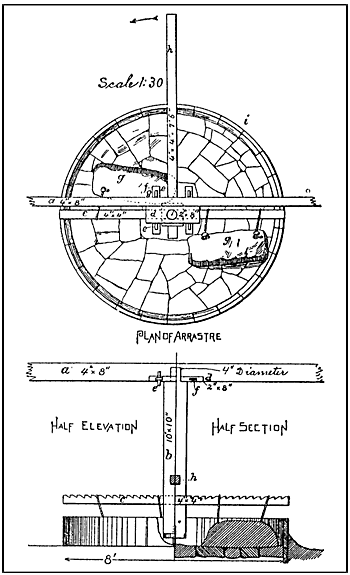Arrastra on:
[Wikipedia]
[Google]
[Amazon]
 An arrastra (or arastra) is a primitive
An arrastra (or arastra) is a primitive
Arrastra
at
 An arrastra (or arastra) is a primitive
An arrastra (or arastra) is a primitive mill
Mill may refer to:
Science and technology
* Factory
* Mill (grinding)
* Milling (machining)
* Millwork
* Paper mill
* Steel mill, a factory for the manufacture of steel
* Sugarcane mill
* Textile mill
* List of types of mill
* Mill, the arithmetic ...
for grinding and pulverizing (typically) gold
Gold is a chemical element; it has chemical symbol Au (from Latin ) and atomic number 79. In its pure form, it is a brightness, bright, slightly orange-yellow, dense, soft, malleable, and ductile metal. Chemically, gold is a transition metal ...
or silver
Silver is a chemical element; it has Symbol (chemistry), symbol Ag () and atomic number 47. A soft, whitish-gray, lustrous transition metal, it exhibits the highest electrical conductivity, thermal conductivity, and reflectivity of any metal. ...
ore
Ore is natural rock or sediment that contains one or more valuable minerals, typically including metals, concentrated above background levels, and that is economically viable to mine and process. The grade of ore refers to the concentration ...
. Its simplest form is two or more flat-bottomed drag stones placed in a circular pit paved with flat stones, and connected to a center post by a long arm. With a horse, mule or human providing power at the other end of the arm, the stones were dragged slowly around in a circle, crushing the ore. Some arrastras were powered by a water wheel
A water wheel is a machine for converting the kinetic energy of flowing or falling water into useful forms of power, often in a watermill. A water wheel consists of a large wheel (usually constructed from wood or metal), with numerous b ...
; a few were powered by steam or gasoline engines, and even electricity.
Arrastras were widely used throughout the Mediterranean region since Phoenicia
Phoenicians were an Ancient Semitic-speaking peoples, ancient Semitic group of people who lived in the Phoenician city-states along a coastal strip in the Levant region of the eastern Mediterranean, primarily modern Lebanon and the Syria, Syrian ...
n times. The Spanish
Spanish might refer to:
* Items from or related to Spain:
**Spaniards are a nation and ethnic group indigenous to Spain
**Spanish language, spoken in Spain and many countries in the Americas
**Spanish cuisine
**Spanish history
**Spanish culture
...
introduced the arrastra to the New World
The term "New World" is used to describe the majority of lands of Earth's Western Hemisphere, particularly the Americas, and sometimes Oceania."America." ''The Oxford Companion to the English Language'' (). McArthur, Tom, ed., 1992. New York: ...
in the 16th century. The word "arrastra" comes from the Spanish language
Spanish () or Castilian () is a Romance languages, Romance language of the Indo-European languages, Indo-European language family that evolved from the Vulgar Latin spoken on the Iberian Peninsula of Europe. Today, it is a world language, gl ...
''arrastrar,'' meaning to drag along the ground. Arrastras were suitable for use in small or remote mines, since they could be built from local materials and required little investment capital
In economics, capital goods or capital are "those durable produced goods that are in turn used as productive inputs for further production" of goods and services. A typical example is the machinery used in a factory. At the macroeconomic level ...
.
For gold ore, the gold was typically recovered by amalgamation
Amalgamation is the process of combining or uniting multiple entities into one form.
Amalgamation, amalgam, and other derivatives may refer to:
Mathematics and science
* Amalgam (chemistry), the combination of mercury with another metal
**Pan ama ...
with quicksilver. The miner would add clean mercury to the ground ore, continue grinding, rinse out the fines, then add more ore and repeat the process. At cleanup, the gold amalgam was carefully recovered from the low places and crevices in the arrastra floor. The amalgam was then heated in a distillation retort to recover the gold, and the mercury was saved for reuse.
For silver ore, the patio process
The patio process is a process for extracting silver from ore. Smelting, or refining, is most often necessary because silver is only infrequently found as a native element like some metals nobler than the redox couple 2 + 2 ⇌ (gold, mercury ...
, invented in Mexico in 1554, was generally used to recover the silver from ore ground in the arrastra.
References
External links
*Arrastra
at
Encyclopædia Britannica
The is a general knowledge, general-knowledge English-language encyclopaedia. It has been published by Encyclopædia Britannica, Inc. since 1768, although the company has changed ownership seven times. The 2010 version of the 15th edition, ...
{{Extractive metallurgy
History of mining
History of metallurgy
Mining equipment
Grinding mills